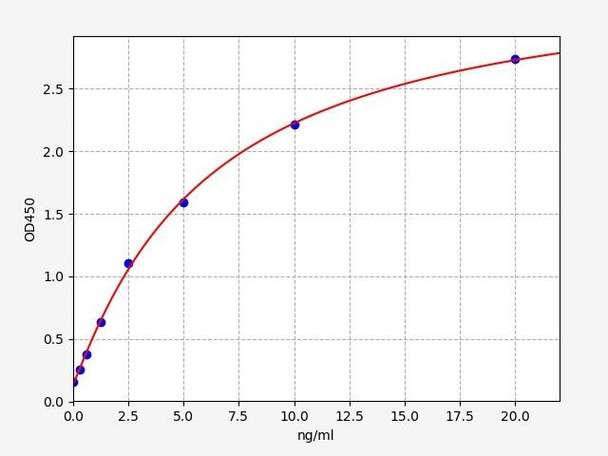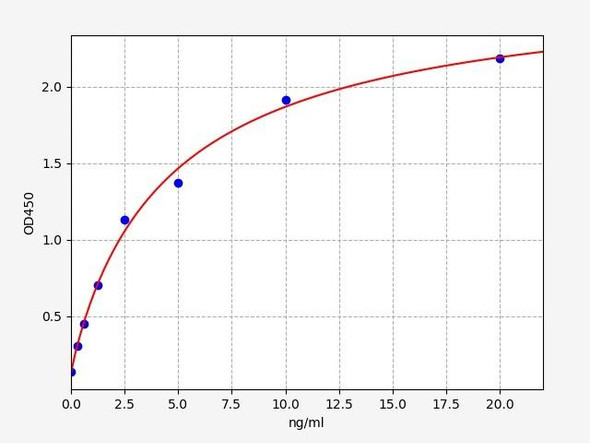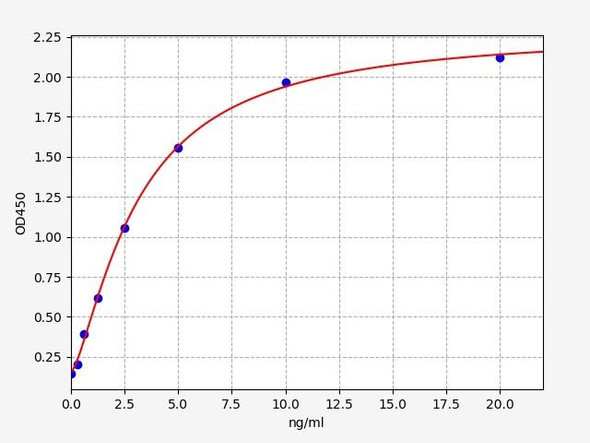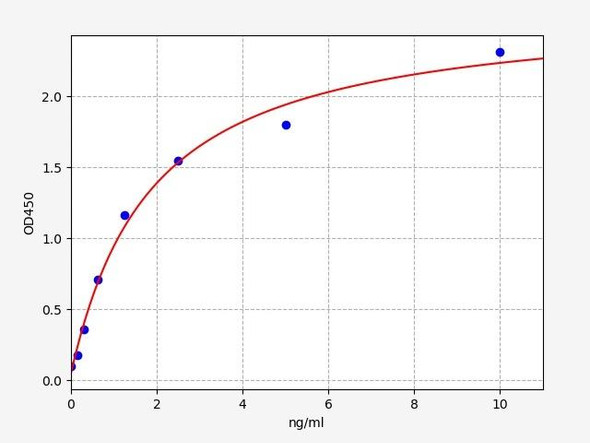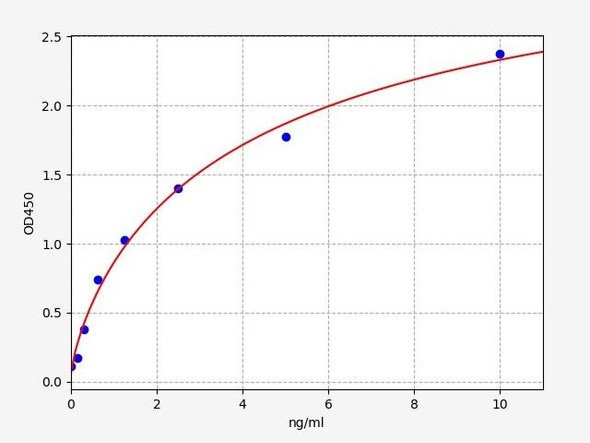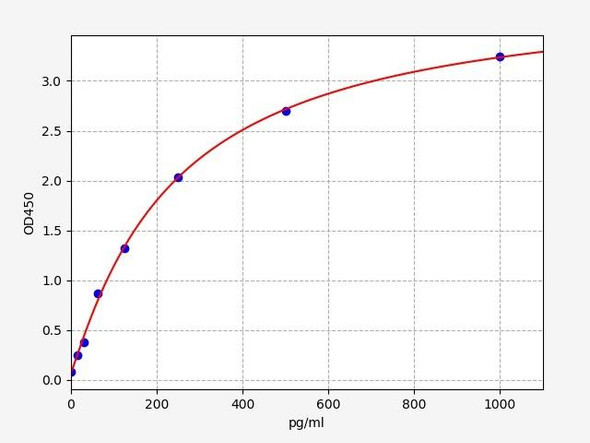Human TIP49A ELISA Kit
- SKU:
- HUFI01923
- Product Type:
- ELISA Kit
- Size:
- 96 Assays
- Uniprot:
- Q9Y265
- Sensitivity:
- 0.188ng/ml
- Range:
- 0.313-20ng/ml
- ELISA Type:
- Sandwich ELISA, Double Antibody
- Synonyms:
- RUVBL1, TIP49a, Pontin 52, Nuclear matrix protein 238, NMP 238, INO80 complex subunit H, TIP60-associated protein 54-alpha, TAP54-alpha, 49 kDa TATA box-binding protein-interacting protein, 49 kDa TBP-interacting protein, 54 kDa erythrocyte cytosolic
- Reactivity:
- Human
Description
| Product Name: | Human TIP49A ELISA Kit |
| Product Code: | HUFI01923 |
| Size: | 96 Assays |
| Alias: | RUVBL1, TIP49a, Pontin 52, Nuclear matrix protein 238, NMP 238, INO80 complex subunit H, TIP60-associated protein 54-alpha, TAP54-alpha, 49 kDa TATA box-binding protein-interacting protein, 49 kDa TBP-interacting protein, 54 kDa erythrocyte cytosolic protein, ECP-54 |
| Detection method: | Sandwich ELISA, Double Antibody |
| Application: | This immunoassay kit allows for the in vitro quantitative determination of Human RUVBL1 concentrations in serum plasma and other biological fluids. |
| Sensitivity: | 0.188ng/ml |
| Range: | 0.313-20ng/ml |
| Storage: | 4°C for 6 months |
| Note: | For Research Use Only |
| Recovery: | Matrices listed below were spiked with certain level of Human RUVBL1 and the recovery rates were calculated by comparing the measured value to the expected amount of Human RUVBL1 in samples. | ||||||||||||||||
| |||||||||||||||||
| Linearity: | The linearity of the kit was assayed by testing samples spiked with appropriate concentration of Human RUVBL1 and their serial dilutions. The results were demonstrated by the percentage of calculated concentration to the expected. | ||||||||||||||||
| |||||||||||||||||
| CV(%): | Intra-Assay: CV<8% Inter-Assay: CV<10% |
| Component | Quantity | Storage |
| ELISA Microplate (Dismountable) | 8×12 strips | 4°C for 6 months |
| Lyophilized Standard | 2 | 4°C/-20°C |
| Sample/Standard Dilution Buffer | 20ml | 4°C |
| Biotin-labeled Antibody(Concentrated) | 120ul | 4°C (Protect from light) |
| Antibody Dilution Buffer | 10ml | 4°C |
| HRP-Streptavidin Conjugate(SABC) | 120ul | 4°C (Protect from light) |
| SABC Dilution Buffer | 10ml | 4°C |
| TMB Substrate | 10ml | 4°C (Protect from light) |
| Stop Solution | 10ml | 4°C |
| Wash Buffer(25X) | 30ml | 4°C |
| Plate Sealer | 5 | - |
Other materials and equipment required:
- Microplate reader with 450 nm wavelength filter
- Multichannel Pipette, Pipette, microcentrifuge tubes and disposable pipette tips
- Incubator
- Deionized or distilled water
- Absorbent paper
- Buffer resevoir
| Uniprot | Q9Y265 |
| UniProt Protein Function: | RUVBL1: Possesses single-stranded DNA-stimulated ATPase and ATP- dependent DNA helicase (3' to 5') activity. Component of the NuA4 histone acetyltransferase complex which is involved in transcriptional activation of select genes principally by acetylation of nucleosomal histones H4 and H2A. This modification may both alter nucleosome - DNA interactions and promote interaction of the modified histones with other proteins which positively regulate transcription. This complex may be required for the activation of transcriptional programs associated with oncogene and proto-oncogene mediated growth induction, tumor suppressor mediated growth arrest and replicative senescence, apoptosis, and DNA repair. The NuA4 complex ATPase and helicase activities seem to be, at least in part, contributed by the association of RUVBL1 and RUVBL2 with EP400. NuA4 may also play a direct role in DNA repair when recruited to sites of DNA damage. RUVBL1 plays an essential role in oncogenic transformation by MYC and also modulates transcriptional activation by the LEF1/TCF1- CTNNB1 complex. Belongs to the ruvB family. Forms homotypic and heterotypic interactions. Forms a multimeric complex with RUVBL2. Interacts with the transcriptional activation domain of MYC. Component of the RNA polymerase II holoenzyme complex. May also act to bridge the LEF1/TCF1-CTNNB1 complex and TBP. Component of the NuA4 histone acetyltransferase complex which contains the catalytic subunit KAT5/TIP60 and the subunits EP400, TRRAP/PAF400, BRD8/SMAP, EPC1, DMAP1/DNMAP1, RUVBL1/TIP49, RUVBL2, ING3, actin, ACTL6A/BAF53A, MORF4L1/MRG15, MORF4L2/MRGX, MRGBP, YEATS4/GAS41, VPS72/YL1 and MEAF6. The NuA4 complex interacts with MYC and the adenovirus E1A protein. RUVBL1 interacts with EP400. Component of a NuA4-related complex which contains EP400, TRRAP/PAF400, SRCAP, BRD8/SMAP, EPC1, DMAP1/DNMAP1, RUVBL1/TIP49, RUVBL2, actin, ACTL6A/BAF53A, VPS72 and YEATS4/GAS41. Component of the BAF53 complex, at least composed of ACTL6A/BAF53A, RUVBL1/TIP49, SMARCA2/BRM, and TRRAP/PAF400. Component of some MLL1/MLL complex, at least composed of the core components MLL, ASH2L, HCFC1/HCF1, WDR5 and RBBP5, as well as the facultative components C17orf49, CHD8, E2F6, HSP70, IN80C, KIAA1267, LAS1L, MAX, MCRS1, MGA, MYST1/MOF, PELP1, PHF20, PRP31, RING2, RUVB1/TIP49A, RUVB2/TIP49B, SENP3, TAF1, TAF4, TAF6, TAF7, TAF9 and TEX10. Associates with alpha and gamma tubulins, particularly during metaphase and early anaphase. Interacts with NPAT. Component of the chromatin-remodeling INO80 complex, at least composed of ACTL6A, ACTR5, ACTR8, RVBL1, RVBL2, INO80, INO80B, INO80C, INO80D and INO80E. Interacts with IGHMBP2. 2 isoforms of the human protein are produced by alternative splicing. |
| UniProt Protein Details: | Protein type:Helicase; EC 3.6.4.12; Motility/polarity/chemotaxis Chromosomal Location of Human Ortholog: 3q21 Cellular Component: nucleoplasm; Golgi apparatus; NuA4 histone acetyltransferase complex; nuclear matrix; membrane; intracellular membrane-bound organelle; cytoplasm; microtubule organizing center; nucleus Molecular Function:DNA helicase activity; protein binding; ATPase activity; ATP binding Biological Process: regulation of transcription from RNA polymerase II promoter; nucleosome assembly; mitosis; establishment and/or maintenance of chromatin architecture; DNA replication-independent nucleosome assembly at centromere; transcription, DNA-dependent; cell division; regulation of growth; spermatogenesis; DNA repair; DNA duplex unwinding; DNA recombination |
| UniProt Code: | Q9Y265 |
| NCBI GenInfo Identifier: | 28201891 |
| NCBI Gene ID: | 8607 |
| NCBI Accession: | Q9Y265.1 |
| UniProt Secondary Accession: | Q9Y265,P82276, Q1KMR0, Q53HK5, Q53HL7, Q53Y27, Q9BSX9 B2R5S0, |
| UniProt Related Accession: | Q9Y265 |
| Molecular Weight: | 456 |
| NCBI Full Name: | RuvB-like 1 |
| NCBI Synonym Full Names: | RuvB-like AAA ATPase 1 |
| NCBI Official Symbol: | RUVBL1 |
| NCBI Official Synonym Symbols: | RVB1; TIH1; ECP54; TIP49; INO80H; NMP238; PONTIN; TIP49A; Pontin52 |
| NCBI Protein Information: | ruvB-like 1; ECP-54; NMP 238; pontin 52; TAP54-alpha; INO80 complex subunit H; nuclear matrix protein 238; RuvB (E coli homolog)-like 1; 49 kDa TBP-interacting protein; TIP60-associated protein 54-alpha; 54 kDa erythrocyte cytosolic protein; TATA binding protein interacting protein 49 kDa; 49 kDa TATA box-binding protein-interacting protein |
| UniProt Protein Name: | RuvB-like 1 |
| UniProt Synonym Protein Names: | 49 kDa TATA box-binding protein-interacting protein; 49 kDa TBP-interacting protein; 54 kDa erythrocyte cytosolic protein; ECP-54; INO80 complex subunit H; Nuclear matrix protein 238; NMP 238; Pontin 52; TIP49a; TIP60-associated protein 54-alpha; TAP54-alpha |
| Protein Family: | RuvB |
| UniProt Gene Name: | RUVBL1 |
| UniProt Entry Name: | RUVB1_HUMAN |
*Note: Protocols are specific to each batch/lot. For the correct instructions please follow the protocol included in your kit.
Before adding to wells, equilibrate the SABC working solution and TMB substrate for at least 30 min at 37°C. When diluting samples and reagents, they must be mixed completely and evenly. It is recommended to plot a standard curve for each test.
| Step | Protocol |
| 1. | Set standard, test sample and control (zero) wells on the pre-coated plate respectively, and then, record their positions. It is recommended to measure each standard and sample in duplicate. Wash plate 2 times before adding standard, sample and control (zero) wells! |
| 2. | Aliquot 0.1ml standard solutions into the standard wells. |
| 3. | Add 0.1 ml of Sample / Standard dilution buffer into the control (zero) well. |
| 4. | Add 0.1 ml of properly diluted sample ( Human serum, plasma, tissue homogenates and other biological fluids.) into test sample wells. |
| 5. | Seal the plate with a cover and incubate at 37 °C for 90 min. |
| 6. | Remove the cover and discard the plate content, clap the plate on the absorbent filter papers or other absorbent material. Do NOT let the wells completely dry at any time. Wash plate X2. |
| 7. | Add 0.1 ml of Biotin- detection antibody working solution into the above wells (standard, test sample & zero wells). Add the solution at the bottom of each well without touching the side wall. |
| 8. | Seal the plate with a cover and incubate at 37°C for 60 min. |
| 9. | Remove the cover, and wash plate 3 times with Wash buffer. Let wash buffer rest in wells for 1 min between each wash. |
| 10. | Add 0.1 ml of SABC working solution into each well, cover the plate and incubate at 37°C for 30 min. |
| 11. | Remove the cover and wash plate 5 times with Wash buffer, and each time let the wash buffer stay in the wells for 1-2 min. |
| 12. | Add 90 µl of TMB substrate into each well, cover the plate and incubate at 37°C in dark within 10-20 min. (Note: This incubation time is for reference use only, the optimal time should be determined by end user.) And the shades of blue can be seen in the first 3-4 wells (with most concentrated standard solutions), the other wells show no obvious color. |
| 13. | Add 50 µl of Stop solution into each well and mix thoroughly. The color changes into yellow immediately. |
| 14. | Read the O.D. absorbance at 450 nm in a microplate reader immediately after adding the stop solution. |
When carrying out an ELISA assay it is important to prepare your samples in order to achieve the best possible results. Below we have a list of procedures for the preparation of samples for different sample types.
| Sample Type | Protocol |
| Serum | If using serum separator tubes, allow samples to clot for 30 minutes at room temperature. Centrifuge for 10 minutes at 1,000x g. Collect the serum fraction and assay promptly or aliquot and store the samples at -80°C. Avoid multiple freeze-thaw cycles. If serum separator tubes are not being used, allow samples to clot overnight at 2-8°C. Centrifuge for 10 minutes at 1,000x g. Remove serum and assay promptly or aliquot and store the samples at -80°C. Avoid multiple freeze-thaw cycles. |
| Plasma | Collect plasma using EDTA or heparin as an anticoagulant. Centrifuge samples at 4°C for 15 mins at 1000 × g within 30 mins of collection. Collect the plasma fraction and assay promptly or aliquot and store the samples at -80°C. Avoid multiple freeze-thaw cycles. Note: Over haemolysed samples are not suitable for use with this kit. |
| Urine & Cerebrospinal Fluid | Collect the urine (mid-stream) in a sterile container, centrifuge for 20 mins at 2000-3000 rpm. Remove supernatant and assay immediately. If any precipitation is detected, repeat the centrifugation step. A similar protocol can be used for cerebrospinal fluid. |
| Cell culture supernatant | Collect the cell culture media by pipette, followed by centrifugation at 4°C for 20 mins at 1500 rpm. Collect the clear supernatant and assay immediately. |
| Cell lysates | Solubilize cells in lysis buffer and allow to sit on ice for 30 minutes. Centrifuge tubes at 14,000 x g for 5 minutes to remove insoluble material. Aliquot the supernatant into a new tube and discard the remaining whole cell extract. Quantify total protein concentration using a total protein assay. Assay immediately or aliquot and store at ≤ -20 °C. |
| Tissue homogenates | The preparation of tissue homogenates will vary depending upon tissue type. Rinse tissue with 1X PBS to remove excess blood & homogenize in 20ml of 1X PBS (including protease inhibitors) and store overnight at ≤ -20°C. Two freeze-thaw cycles are required to break the cell membranes. To further disrupt the cell membranes you can sonicate the samples. Centrifuge homogenates for 5 mins at 5000xg. Remove the supernatant and assay immediately or aliquot and store at -20°C or -80°C. |
| Tissue lysates | Rinse tissue with PBS, cut into 1-2 mm pieces, and homogenize with a tissue homogenizer in PBS. Add an equal volume of RIPA buffer containing protease inhibitors and lyse tissues at room temperature for 30 minutes with gentle agitation. Centrifuge to remove debris. Quantify total protein concentration using a total protein assay. Assay immediately or aliquot and store at ≤ -20 °C. |
| Breast Milk | Collect milk samples and centrifuge at 10,000 x g for 60 min at 4°C. Aliquot the supernatant and assay. For long term use, store samples at -80°C. Minimize freeze/thaw cycles. |

